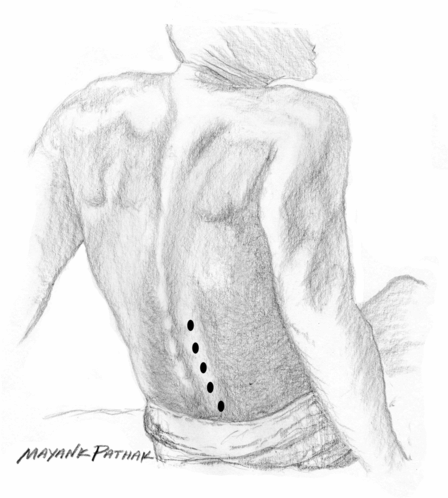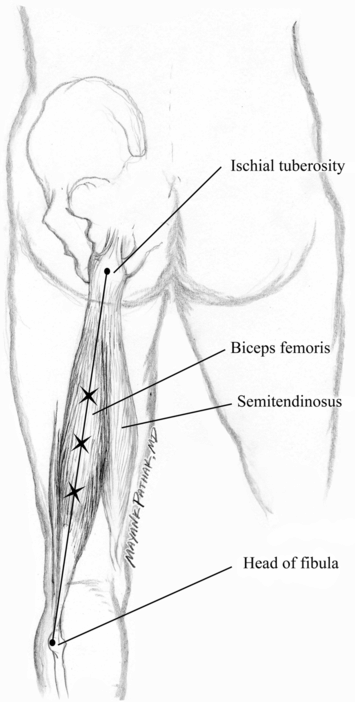Fig. 19.1 Anatomy of low-back muscles based on Gray’s Anatomy. As shown in the figure, the superficial erector spinae make a single mass in the lumbar region (right side).
On the lower end, some of the fibers of erector spinae are continuous with those of the multifidus and gluteus maximus muscles (Williams et al., 1995). The multifidus muscle (Fig. 19.1) lies deep and medially to erector spinae and is made up of muscle bands (multifidii) that cross obliquely upward and attach to the whole length of the spine of each vertebrae. The lowest multifidus band is attached to sacral vertebra 4. Multifidus bands stabilize and to some degree rotate the spine. Deeper muscles such as rotatores (cervicis, thoracis and lumborum) mainly rotate the spine. Short interspinales and intertransversalis muscles are stabilizers and rotators and play an important role in maintaining posture.

Fig. 19.2 In most individuals, the erector spinae are easily visible and palpable in the lumbar area. The figure shows the site of injections in one side (40–50 U/site). Patients with stiff-person syndrome usually require bilateral treatment.
Early treatment reports
Davis and Jabbari (1993) first reported significant improvement of “muscle stiffness” and painful muscle “spasms” with onabotulinumtoxinA (Botox) in a 36-year-old man who developed clinical features of typical SPS over a period of 18 months. The rigidity and painful muscle spasms involved mainly the paraspinal muscles at the T12 to L5 level. His anti-GAD antibody titers (Mayo Clinic laboratory) were 1/122 000 in serum (normal <1/120) and 1/128 (normal <1/2) in cerebrospinal fluid. Treatment with baclofen and high-dose diazepam (100mg daily) provided only partial relief. OnabotulinumtoxinA was injected at five levels (L1–L5) into the paraspinal muscles bilaterally, 40–50 U/level for a total of 560 U. Within a week, the patient reported marked reduction in muscle spasms along with improvement of sleep and ambulation. On examination, a reduction in the board-like rigidity of paraspinal muscles was noted. Over a follow-up period of 3 years, four additional treatments of 400 U (200 U per side) maintained relief.
In a blinded study by Liguori et al. (1997), two patients who received onabotulinumtoxinA showed improvement of muscle rigidity and muscle spasm. The patients were 58 and 59 years of age with probable stiff-limb variant of SPS and raised anti-GAD antibodies. In one patient, a number of lower limb muscles (adductors magnus and longus, biceps femoris, tibialis posterior, gastrocnemius and soleus) were injected with doses ranging from 50 to 100 U/muscle. The second patient was injected in the trapezius, deltoid and biceps with doses of 50–300 U/muscle. Both muscle rigidity and muscle spasm showed significant improvement. The authors reported continued responsiveness with smaller doses over a 2-year follow-up period.
The Yale treatment protocol
Thoracolumbar paraspinal muscles in typical stiff-person syndrome
In typical SPS with board-like rigidity of back muscles, the superficial paraspinal muscles (erectors of the spine) in the thoracolumbar region are the main focus of treatment. Since some fibers of the erector spinae are continuous with the multifidii and glutei in the lumbosacral region, treatment of the erector spinae at this level with a sufficient dose can theoretically also affect at least a part of the deeper muscles.
OnabotulinumtoxinA is prepared with preservative-free saline to the strength 100 U/ml. For injection, the solution is drawn into a 1 ml syringe, using a 37.5 mm (1.5 inch), 27-gauge needle. It is our view that treatment of low-back spasms and rigidity in SPS should include injections at multiple sites/levels (at least five) because of the length of the erector muscles (Fig. 19.2). Furthermore, an adequate dosage at each level is needed in order to ensure sufficient lateral, longitudinal and depth spread of the solution. While there is experience only with onabotulinumtoxinA for SPS, there is no reason to think that other forms of toxin would not be similarly effective.
After careful inspection and palpation of the back, the silhouette of erector muscles (medial and lateral borders) can be identified in most patients without difficulty (Fig. 19.2). Injection into erector muscles is made perpendicular to the surface with the patient either in the sitting position or lying down on the stomach or side. In a thin individual, an injection to the depth of 1.9–2.5 cm (0.75–1 inch) is sufficient. In larger individuals the depth of injection varies from 2.5 cm (1 inch) to 3.75 cm (1.5 inches). Five paraspinal levels are injected on each side: 40–50 U/site (total dose per session 400–500 U). In typical SPS, the injected area usually includes L1 to L5 or T12 to L4. Injections are performed under electromyographic guidance.
Limb muscles in stiff-limb syndrome or typical stiff-person syndrome with proximal limb rigidity
Solution preparation, syringe and needle length are the same as that described above for rigid axial/paraspinal muscles. The method of injection is similar to that currently widely used for treatment of spasticity: two to four injections in the affected muscles (Figs. 19.3 and 19.4). Some physicians use larger volumes of 2 ml (50 U/ml) or 4 ml (25 U/ml) dilution in an attempt to achieve better diffusion into the muscle with larger volumes. Comparative studies are needed to prove the merits of larger volumes. Injections are performed under electromyographic guidance.

Fig. 19.3 For hamstring spasticity, injections into biceps femoris may be made in three or more sites with a dose of 30–50 U/site.
Stay updated, free articles. Join our Telegram channel

Full access? Get Clinical Tree


